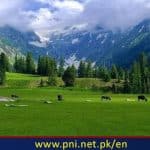KARACHI, Green denoting cleanliness and freshness, has turned to be a buzz word across the country with major focus on braving the challenges of pollution, global warming and climate change registered to affect atmosphere, public health, livelihood and ultimately the economy.
Scenario in the context of Karachi is also no different with different groups, organizations and people in their individual capacities trying to help the city be provided with the much required “green cover” during the ongoing, country wide, monsoon season tree plantation.
Need for a comprehensive approach ensuring that campaigns are organized with due care towards sustainability is, however, generally felt to be a missing link that otherwise is critical averting possible loss of material resources, time and efforts put in by people with the best of intentions.
“Ecological compatibility of chosen trees coupled with optimum care towards sustainability and deep sense of ownership are key requirements for the success of efforts being made towards the cause,” commented Dr. Rafi ul Haq, a senior plant ecologist.
As per available literature the industrial hub of the country that falls in arid zone has its indigenous varieties, that fortunately are quite wide, matching the specified conditions in terms of its
ecosystem. People keen to plant fruit trees can go for Jujuba , Moringa, Chiku, Jungle Jalebi, Lasura, Shareefa or Custardapple.
For flowering trees, the choice could be Amaltas , Gul Mohar and Lignum (which is not local but acclimatized). Shady trees including Neem, Peepal, Banyan, Siris and Bakain can particularly help counter the heat island risks.
All these along with certain other varieties that may not be indigenous but are low cost, compatible to local conditions and can be grown well with a little care are also readily available.
A public park, “Kidney Hill,” is a good example with more than 53 different species being successfully planted, during the past few years, under the supervision of a senior civil servant in close coordination with an NGO Shehri – Citizens for A Better Environment, comprising committed citizens from different walks of life.
“We have managed to plant 130,000 trees of different varieties, many of which can be noticed having fruits while several other blossoming with flowers,” said Dr. Saif ur Rehman, former municipal commissioner of Karachi, who took upon himself the task to make the park one of its kind of public space.
“These are also attracting insects, bees and butterflies (integral components of habitat),” added the jubilant MBBS doctor by qualification.
Dr.Haq, hopeful that it might be replicated by other stakeholders too with equal attention to maintain the spirit when asked about risks associated with “non alien” plants and trees warned that these could not only affect ecosystems but also hazardous to human health, reminding implications of Paper Mulberry in Islamabad.
In context of Karachi he referred to damage caused by Eucalyptus and Conocarpus, both playing havoc with the local environment besides causing damage to underground water supply as well as sewerage lines.
“Ours being a resource constrained country demands extreme care in making choices ensuring that they are environment friendly, essentially shade providers and are not water intensive,” said Abdul Hadi, a retired banker involved in efforts to restore abandoned green belts and parks for the past few years.
Elaborating his stance, the senior citizen emphasised that since water was turning into a fast diminishing commodity authorities had to seriously contemplate for a pragmatic approach to help treatment of waste water on scientific lines.
People participating in tree plantation campaigns were strongly recommended to be adequately sensitized about relevance of sustainability of the exercise and means to achieve the same through proper and regular education with equal realization that plantation could not be done round the year but during specific seasons – Spring (Mid February to Mid April) and Monsoon (Mid July to Mid September).
There are, however, many in Karachi who do not agree with season specific plantations for the metropolis and Shahzad Qureishi, the pioneer of the Urban Forest project is among them.
“Karachi with moderate / mild and almost similar weather conditions during 12 months is an exceptional case where trees can be planted any time with due care towards certain basics, ” he said.
Mrs. Amra Javed, an activist representing Shehri-Citizens For A Better Environment said attention was being paid to motivate citizens in general towards protection of trees and plants in their neighbourhoods.
“This is very important as Karachi needs no less than 1.4 million trees to absorb carbon emissions from our environment and generate much needed oxygen for our industrial cum commercial center,” said Dr. Rafi ul Haq.
“I, however, do believe that the goal to turn the city Green has to be institutionalized as well as specialized as haphazard and scattered activities do spoil the efforts at large scale causing a serious sense of disillusionment among many well meaning and motivated individuals.
The plant ecologist emphasizing the importance of micro-management for mass level campaigns appreciated that the approach has been efficiently adopted for the 10 Billion Tree Tsunami Program under the supervision of the PM’s Special Assistant on Climate Change (Federal Minister) Malik Amin Aslam.
Follow the PNI Facebook page for the latest news and updates.








